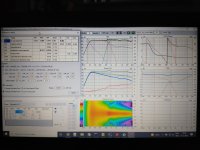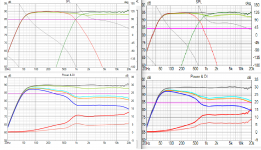The optimizer is trying to make the blue/red/green curve more straight at the expense of the on-axis 900Hz bump.
I don't think DSP can solve that. I have been playing with other crossover points and even a 12" woofer, but I can't get much better...
I don't think DSP can solve that. I have been playing with other crossover points and even a 12" woofer, but I can't get much better...
Directivity Index of the waveguide seems to be very high >10db, already below 1kHz and there is mismatch to the woofers much lower DI there. You could check out if it works fine with 18" woofer, or make the waveguide smaller so that DI is falling through 10db around 1kHz to match directivity of 15" driver. Basically, check out ideal 15" driver DI (or measured one if you already have enclosure for it) and try to match that with your waveguide around the crossover, you can then use crossover anywhere you like where the directivities overlap without issues like this.
I'm not sure how the new R-OSSE works but I think there was only one parameter (diameter or depth or something) in the previous scripts which one could use to scale a design without affecting much on the response other than sliding the features up or down in frequency.
edit. Looked again the graph, this seems to be only ~2dB issue, not biggie and most speakers have worse anomalies anyway. Now that you haven't manufactured anything yet, perhaps try to scale the waveguide a little bit smaller and see if it smoothens it, which would make it as good as possibl.
edit2. you are able to simulate, try simulating woofer enclosure width and depth to manipulate its directivity below 1kHz, like emabat sims in the ATH thread recently showed https://www.diyaudio.com/community/threads/acoustic-horn-design-the-easy-way-ath4.338806/page-476.
I'm not sure how the new R-OSSE works but I think there was only one parameter (diameter or depth or something) in the previous scripts which one could use to scale a design without affecting much on the response other than sliding the features up or down in frequency.
edit. Looked again the graph, this seems to be only ~2dB issue, not biggie and most speakers have worse anomalies anyway. Now that you haven't manufactured anything yet, perhaps try to scale the waveguide a little bit smaller and see if it smoothens it, which would make it as good as possibl.
edit2. you are able to simulate, try simulating woofer enclosure width and depth to manipulate its directivity below 1kHz, like emabat sims in the ATH thread recently showed https://www.diyaudio.com/community/threads/acoustic-horn-design-the-easy-way-ath4.338806/page-476.
Last edited:
It's obviously a wrong target, this is not a good result.The optimizer is trying to make the blue/red/green curve more straight at the expense of the on-axis 900Hz bump.
I don't think DSP can solve that. I have been playing with other crossover points and even a 12" woofer, but I can't get much better...
Of course DSP can solve that. What do you mean that it can't?
I have one of Sean Olive's preference ratings as a target.
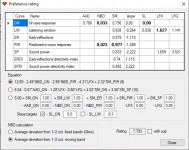
The preference rating depends on the Narrow Band Deviation of the on-axis response (NBD_ON), NBD of the Predicted In-Room Response (NBD_PIR) and the smoothness of the Predicted In-Room Response (SM_PIR).
A DSP can solve the hump around 900Hz and will improve NBD_ON I guess. Simultaneously it will deteriorate NBD_PIR and SM_PIR as those are coupled together by the waveguide geometry. You might be able to influence it a with the cross over.
The above is, I think, the same as this:
"EQ cannot fix ANY acoustical problems whether they are from waveguides or direct radiators. They can do "perfect" correction at a single point - by making ALL other points worse." Gedlee
https://www.diyaudio.com/community/threads/geddes-on-waveguides.103872/post-2654496

The preference rating depends on the Narrow Band Deviation of the on-axis response (NBD_ON), NBD of the Predicted In-Room Response (NBD_PIR) and the smoothness of the Predicted In-Room Response (SM_PIR).
A DSP can solve the hump around 900Hz and will improve NBD_ON I guess. Simultaneously it will deteriorate NBD_PIR and SM_PIR as those are coupled together by the waveguide geometry. You might be able to influence it a with the cross over.
The above is, I think, the same as this:
"EQ cannot fix ANY acoustical problems whether they are from waveguides or direct radiators. They can do "perfect" correction at a single point - by making ALL other points worse." Gedlee
https://www.diyaudio.com/community/threads/geddes-on-waveguides.103872/post-2654496
Directivity Index of the waveguide seems to be very high >10db, already below 1kHz and there is mismatch to the woofers much lower DI there. You could check out if it works fine with 18" woofer, or make the waveguide smaller so that DI is falling through 10db around 1kHz to match directivity of 15" driver. Basically, check out ideal 15" driver DI (or measured one if you already have enclosure for it) and try to match that with your waveguide around the crossover, you can then use crossover anywhere you like where the directivities overlap without issues like this.
I'm not sure how the new R-OSSE works but I think there was only one parameter (diameter or depth or something) in the previous scripts which one could use to scale a design without affecting much on the response other than sliding the features up or down in frequency.
edit. Looked again the graph, this seems to be only ~2dB issue, not biggie and most speakers have worse anomalies anyway. Now that you haven't manufactured anything yet, perhaps try to scale the waveguide a little bit smaller and see if it smoothens it, which would make it as good as possibl.
edit2. you are able to simulate, try simulating woofer enclosure width and depth to manipulate its directivity below 1kHz, like emabat sims in the ATH thread recently showed https://www.diyaudio.com/community/threads/acoustic-horn-design-the-easy-way-ath4.338806/page-476.
Yeah, I'm trying with 15" and 12" woofers and 38cm and 45cm waveguides, but I don't get the expected result. I might have to reject (simulated) reality or I just don't understand it (yet)...
Complete simulation in ABEC would be nice, but I don't have the hardware for it; just an old laptop. I tried to circumvent that by using VituixCAD.
yeah you should be able to do it in vituixcad. Mute either the woofer or waveguide and see the DI graph each playing alone. I suspect you see the waveguide has higher DI below 1kHz, than the woofer.
You could perhaps just change ath script and compare the DI in the standard report if it got closer to what you see with the 15" woofer.
It is like your waveguide is too good 😀 just make it bit smaller to match directicity of the woofer better. For 12" youd need even smaller waveguide
You could perhaps just change ath script and compare the DI in the standard report if it got closer to what you see with the 15" woofer.
It is like your waveguide is too good 😀 just make it bit smaller to match directicity of the woofer better. For 12" youd need even smaller waveguide
I would try to shift the high-pass knee of the tweeter a bit higher and shape the response so the summed response is more or less flat. You are still far from what's possible, IMO, and that's still what you can do with the DSP. I would leave the Olive metric at this point, it can easily lead you astray as it obviously only works up to some degree. You just can't follow it blindly.
Last edited:
That's still the same and easily resolvable problem, IMO. Just play with the filters manually (including the "Q" of the HP knee - try a lower) for a while and you should get the idea quickly...
What is happening is that the optimizer is using EQ to try and get a smoother more even slope to the PIR which funnily enough is exactly what Earl is warning against in the quote.I have one of Sean Olive's preference ratings as a target.
The preference rating depends on the Narrow Band Deviation of the on-axis response (NBD_ON), NBD of the Predicted In-Room Response (NBD_PIR) and the smoothness of the Predicted In-Room Response (SM_PIR).
A DSP can solve the hump around 900Hz and will improve NBD_ON I guess. Simultaneously it will deteriorate NBD_PIR and SM_PIR as those are coupled together by the waveguide geometry. You might be able to influence it a with the cross over.
The above is, I think, the same as this:
"EQ cannot fix ANY acoustical problems whether they are from waveguides or direct radiators. They can do "perfect" correction at a single point - by making ALL other points worse." Gedlee
You have to be careful with optimizing to the preference ratings with a speaker design like this, JBL's own M2 does not score as highly as it may rate in actual performance.
Optimizing to the score works better with rising DI speakers, that should not be a surprise as the majority of the data used in it's creation came from rising DI speakers. You see this also in your 12" example.
A good target to start with for the bigger waveguide would be a 0.2dB/oct fall to the listening window response as the DI is pretty flat. There will be a kink in the PIR and power response where the woofer has less directivity. That is OK and not a problem to be solved by making the direct sound worse.
When optimizing to the score runs contrary to the findings of the research that went into making it it's time to pick a different target.
I would try to shift the high-pass knee of the tweeter a bit higher and shape the response so the summed response is more or less flat. You are still far from what's possible, IMO, and that's still what you can do with the DSP. I would leave the Olive metric at this point, it can easily lead you astray as it obviously only works up to some degree. You just can't follow it blindly.
I think you would like to see something like this:
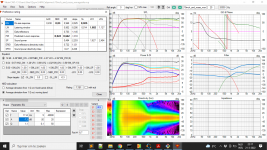
Very flat on axis. But the Olive preference rating is significantly reduced. You state that it may lead one astray, but is the result of some extensive tests and research.
What follows is my current understanding:
What I have picked up in my ongoing journey in speaker building is that on axis frequency response is not the holy grail. Too bad actually as getting it flat with a DSP seems quite easy. The whole thing about controlled directivity is that quite a bit of the sound you hear is off-axis sound that is reflected towards you. The directivity has to be such that the frequency reponse of all the sound that reaches you has to be smooth. A lot of that is not fixable by DSP, but has to be 'designed in' the speaker and more specifically the waveguide. A DSP can make the frequency response flat, but not the angle response.
I have some quotes in my head, but unfortunately I haven't been able to find them. Bit of a bummer...
It's best to try it for yourself - with a DSP it costs you nothing. I would bet that the broad midrange bump shown would sound unnatural and annoying in the long run.
The problem is that from what I've read that you cannot DSP everything.
I found a quote in the mean time:
"... On the other hand in Figure 6 there is no single correction curve to the left plot as the right “corrected”
plot shows. Along the central axis everything has been corrected to be perfectly flat, but in no way, shape, or form is the
problem “corrected”. In fact it might even be worse. It should be obvious that electronic EQ can correct for any linear problem found in a loudspeaker prior to the acoustic domain, but it does not correct for problems within the acoustic domain itself, except along a single direction, i.e. a single point. This is independent of whether or not this problem comes from the speaker or the room itself. The correction is valid only at that single point in space and nowhere else. This is a key point. Let's now look at what a more typical acoustic problem might look like, i.e. a band-limited diffraction, sort of like an acoustic resonance. This is shown in the Figure 7 on page 5. While the effect is somewhat localized in frequency, no electronic correction can possibly fix this issue globally. ..." [http://www.gedlee.com/Papers/directivity.pdf]
I found a quote in the mean time:
"... On the other hand in Figure 6 there is no single correction curve to the left plot as the right “corrected”
plot shows. Along the central axis everything has been corrected to be perfectly flat, but in no way, shape, or form is the
problem “corrected”. In fact it might even be worse. It should be obvious that electronic EQ can correct for any linear problem found in a loudspeaker prior to the acoustic domain, but it does not correct for problems within the acoustic domain itself, except along a single direction, i.e. a single point. This is independent of whether or not this problem comes from the speaker or the room itself. The correction is valid only at that single point in space and nowhere else. This is a key point. Let's now look at what a more typical acoustic problem might look like, i.e. a band-limited diffraction, sort of like an acoustic resonance. This is shown in the Figure 7 on page 5. While the effect is somewhat localized in frequency, no electronic correction can possibly fix this issue globally. ..." [http://www.gedlee.com/Papers/directivity.pdf]
No that is wrong in a different way, if you want to post the Vituix project I will try and show you what I mean.I think you would like to see something like this:
This what JBL does with the M2 and I am suggesting to do something very much the same except slope the on axis and listening window down by 0.2dB /oct
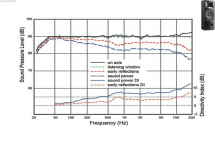
Learning the lessons of the research done is what is important and not prioritizing the score. Have a look here at Pierre's auto EQ algorithm on the M2 data. His algorithm targets a specific slope to the PIR to improve the score. Floyd Toole would not like the resonance created at 4 to 500Hz.
https://pierreaubert.github.io/spinorama/speakers/JBL M2/JBL/index_vendor.html
This is correct but I think you are missing the wood for the trees. Forcing the on axis flat is no different to forcing the PIR to be a specific slope when the directivity does not allow it. Neither is right and neither is what the research suggests be done. There needs to be a balance between on axis and listening window and off axis sound. Sometimes to compromise one or other of these gives a better overall result.What follows is my current understanding:
What I have picked up in my ongoing journey in speaker building is that on axis frequency response is not the holy grail. Too bad actually as getting it flat with a DSP seems quite easy. The whole thing about controlled directivity is that quite a bit of the sound you hear is off-axis sound that is reflected towards you. The directivity has to be such that the frequency reponse of all the sound that reaches you has to be smooth. A lot of that is not fixable by DSP, but has to be 'designed in' the speaker and more specifically the waveguide. A DSP can make the frequency response flat, but not the angle response.
I have some quotes in my head, but unfortunately I haven't been able to find them. Bit of a bummer...
I can guarantee you that a response that dips at either end with a hump at 900Hz will not sound good no matter what the score tells you. The score can be gamed to produce an unrealistically high result with a response that is clearly wrong.
All of the quotes from Earl are correct, there is no acoustic problem in the design that needs to be fixed with EQ. What needs to be done is set the correct tonal balance and make a good directivity match to the woofer with the crossover. This is the advice that Earl would give you himself.
To give you an overview have a look at this list of speakers that are ranked by score.
https://pierreaubert.github.io/spinorama/scores.html
All of the speakers near the top are all following the lessons of the Olive / Toole research. They all score well and they all look very much like what I am suggesting to do. You can also see what Pierre's EQ strategy of making the PIR fit a target does. Sometimes it makes the result better but sometimes I don't think it does, but it always helps the score.
https://pierreaubert.github.io/spinorama/scores.html
All of the speakers near the top are all following the lessons of the Olive / Toole research. They all score well and they all look very much like what I am suggesting to do. You can also see what Pierre's EQ strategy of making the PIR fit a target does. Sometimes it makes the result better but sometimes I don't think it does, but it always helps the score.
I've had a look, the raw waveguide response is a bit odd, I'm not sure that would reflect reality but if it does it will be a bit tricky on the low end. I had to use a bunch of shelving filters instead of a 1st order highpass to flatten the waveguide. I think you can see the general idea. I didn't go any further because the low end of the waveguide is making things awkward and I would mainly be compensating for that.
As you were looking at it the preference rating is 6.7 rising to 8.6 with a sub which is not bad considering, and shows most of it is due to lack of low end from the woofer pulling the score down.
As you were looking at it the preference rating is 6.7 rising to 8.6 with a sub which is not bad considering, and shows most of it is due to lack of low end from the woofer pulling the score down.
Attachments
After having played around with it, your version has compensated the woofer / waveguide directivity to be smoother but because of the slightly odd waveguide response it introduces a bow to the listening window making it peak by a few db's around 6 to 7K. In mine the waveguide is flatter in all curves until the directivity of the waveguide starts to rise. I think this would better represent reality.@fluid What is wrong with my version and what were you trying to achieve with your version? To the untrained eye, and I have two of those, they seem pretty similar.
And what is weird in the raw waveguide files? Should I be worried?
If you look at the raw response on the low end the roll off after the peak levels out to a steady state level. I think this is either due to your data export or vituix interpolating data that was not in your file.
Sometimes the easiest way is to export a normalized response and set the reference angle in Vituix to the normalizing angle and then add a fake tweeter rolloff with a filter to represent what you hope to get. It is difficult to get good phase data export out of VACS and without it any crossover simulation is going to be limited in accuracy anyway.
- Home
- Loudspeakers
- Multi-Way
- Efficient 2-way
